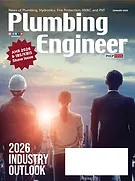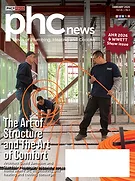It was in the mid-1990s when I first started designing and installing radiant floor systems. Prior to doing so, I was working for heating contractor getting some on-the-job training working with an old plumber turned fitter. I also had attended many training classes and read a few books, I wanted to be well-versed in this emerging industry. I wanted to be responsible for the installs from start to finish.
I believe the biggest point of emphasis is controlling the supply water temperature going to the in-floor manifolds, especially when embedded in concrete or gypcrete.
There are several reasons for good control of the supply water temp. The most important reason is so the floor surface temp does not exceed 87 degrees. In cases with wood floors, keeping the surface temp at 80 degrees is best. This minimizes the chances of adversely affecting the hardwood floor and still have a warm floor for comfort.
The 87 degrees is more for comfort on people’s feet. I have seen too many floor coverings being ruined because of poor design and controls. I pushed ceramic tile over vinyl floor because I had seen the heat stripes on vinyl when the supply water temp was not properly controlled and got too hot. On the positive side of this, you wouldn’t need an infrared camera to see where the loops are!
Comfort and Efficiency
Another very important reason is to give the customer what they desire and are willing to pay extra for – comfort. And I would say the second reason a customer is willing to pay more for radiant is the energy savings.
In designing a good quality system, it pays off in the end for both comfort and efficiency by keeping the supply temp as low as possible. Part of this equation is having 6-inch tube spacing in any hard surface areas, such as tile, hardwood, vinyl and bare concrete.
Extra tube in a system is cheap insurance and really the cheapest part of the system’s installed cost. Doing this allows the supply temps to be as low as can be to match the heat loss of the room.
Most of the time I am designing with 90 degrees to 100 degrees. Keep in mind when I say design temp, I mean the supply water at the outdoor design temp required for your locality. I live in an area where winters can be very harsh. I also use negative 25 degrees for my designs.
Before the introduction of condensing boilers, we were stuck having temps coming out of the boiler at 150 degrees to 200 degrees. Controls to get down to radiant floor temps were required.
Back then and even today I see way too many thermostatic mixing vales installed. Using this type of valve pretty much means you will have a fixed supply temp throughout the heating season. If in your design, the supply temp needed to be 110 degrees, this temp is only needed on a very small portion of the heating season.
In more and more cases, in a heating season, we may not even get to the design low at all. The lack of quality control will adversely affect the comfort of the space, mainly because of the cycling due to the thermostat differential. Not to mention what this can do to the equipment when over cycling.
Mixing Strategies
In my opinion the best option, if mixing is needed, is to have a modulating mixing strategy with outdoor reset. When using a condensing boiler, it prefers the coldest return water temp possible for the over efficiency of the boiler. The type of valve best to achieve this is using a three-way. On that valve would be a motorized actuator.
The control giving the actuator position signal would have an adjustable programed outdoor reset ratio or heat curve. This type of mixing control means the supply temp could vary quite a bit over the heating season. This means lower return temps throughout the heating season.
Here’s an example of what I mean: 70 degrees indoor, minus 25 degrees outdoor = 95-degree temperature difference design. The system minimum 77 degrees; max design 110 degrees = 33-degree temperature change. This is the equation to get the ratio: 33 degrees ÷ 95 degrees = 0.347 heating curve setting. Most controls only go up by one, so I would set it at 0.4. This means every 1-degree outdoor temperature change, the supply water changes by 0.4 of a degree. 95 degrees x 0.4 = 38 degrees + 77 degrees = 115 degrees at minus 25 degrees. This will improve comfort and save money for your customer.
Current boiler design and technology has them as efficient as physics will allow. At best a condensing boiler could see 98% combustion efficiency if the oxygen is close to 4% and carbon dioxide 9.5% or better. The carbon dioxide percentage can adversely affect the flue gas dew point. At carbon dioxide level of 9.5%, the dew point is 132 degrees, but at a carbon dioxide level of 8%, the dew point is 122 degrees.
This means the return water has to be 10-degrees colder to get the same efficiency. Along with this great combustion reading, very cold return water is needed to get the possible 98%. In fact, the return temp would have to be around 50 degrees or 60 degrees, depending on the flow rate compared to the firing rate of the burner.
All condensing boilers on the market today have 95% AFUE. But without getting the return temp very low, the boiler will never even be 95%.
In most cases the system design is adversely affecting the boiler’s efficiency. The boiler’s ability to condense is based on the return flow temp to the boiler. Even if you have baseboard that needs 180 degrees, but also have other low temp zones in the system, you can get the efficiency of 90% or more if you can get the return down to 130 degrees, provided the carbon dioxide is 9%.
Design Considerations
Here are some design considerations to get the return temps low:
Like I mentioned earlier, closer spacing and more tubing is very affective. In a house, I don’t recommend increasing the Delta T over 20 degrees, but in a garage or shop, 30 degrees or 35 degrees can work just fine. Variable speed pumping helps keep the Delta T at design. Using a hydro separator over closely spaced tees is a benefit.
For example: If there is radiant in the garage as well as the house, I would pipe the supply to the garage manifold off the common return pipe going to the boiler or hydro separator.
This way I’m using the return water after it has lost its temperature in the main system. Then the return water coming from the garage floor will further reduce the return temp going to the boiler. If the flow rates of the two areas are similar, this could in effect, increase the Delta T x 2 or more. If the house was at 20 degrees and the garage at 30 degrees, that is 50 degrees! This is possible in systems I have done because the home owner only wanted the garage kept at 45 degrees or 50 degrees, so the supply temp would only need to be 80 degrees or 90 degrees.
For the system in my house, I am using a very unique five-way mixing valve in a prefabricated panel. This is a product I brought over from Germany. One panel called the 2 x 4 will feed two different zones needing different temperatures. It has the ability to use the return water of the higher temp and reuse it for the lower temp needed. This increases the Delta T going back to the boiler. This is achieved by the modulating actuator changing to keep the lower temperature at calculated set point.
My house was built in 1961, originally installed with fin tube baseboard needing 170-degree max supply temp. Most of that is still in use.
I am slowly remodeling the house and adding in some dry above radiant needing 140 degree max supply temp. I put an addition on the house and there it is very low temp radiant in concrete, max 85-degree supply.
Lastly I added radiant into my garage with a 2-inch over pour of concrete. This is just getting the remaining temperature that is left over in the return. My garage stays between 45 degrees and 50 degrees in the coldest conditions. I am using three of the five-way mixing panels to stretch the Delta T between 40 degrees and 70 degrees depending how cold it is outside. When the boiler needs to output 170 degrees for the baseboard, it will only be 100 degrees return back to the boiler from the hydro separator.
I’m writing this on Feb 22nd and where I live the outdoor temp is 22 degrees. Current outgoing boiler temp is 145 degrees. Boiler is fired at 30%, current flue gas temp is only 115 degrees, return temp is 100 degrees.
Low boiler return temperature is possible, even for a retrofit application.
After running his own business for many years, Ted Schmelling made the switch to becoming a manufacturers rep. He’s currently territory sales specialist at Hot Water Products Inc., Milwaukee, Wis.





